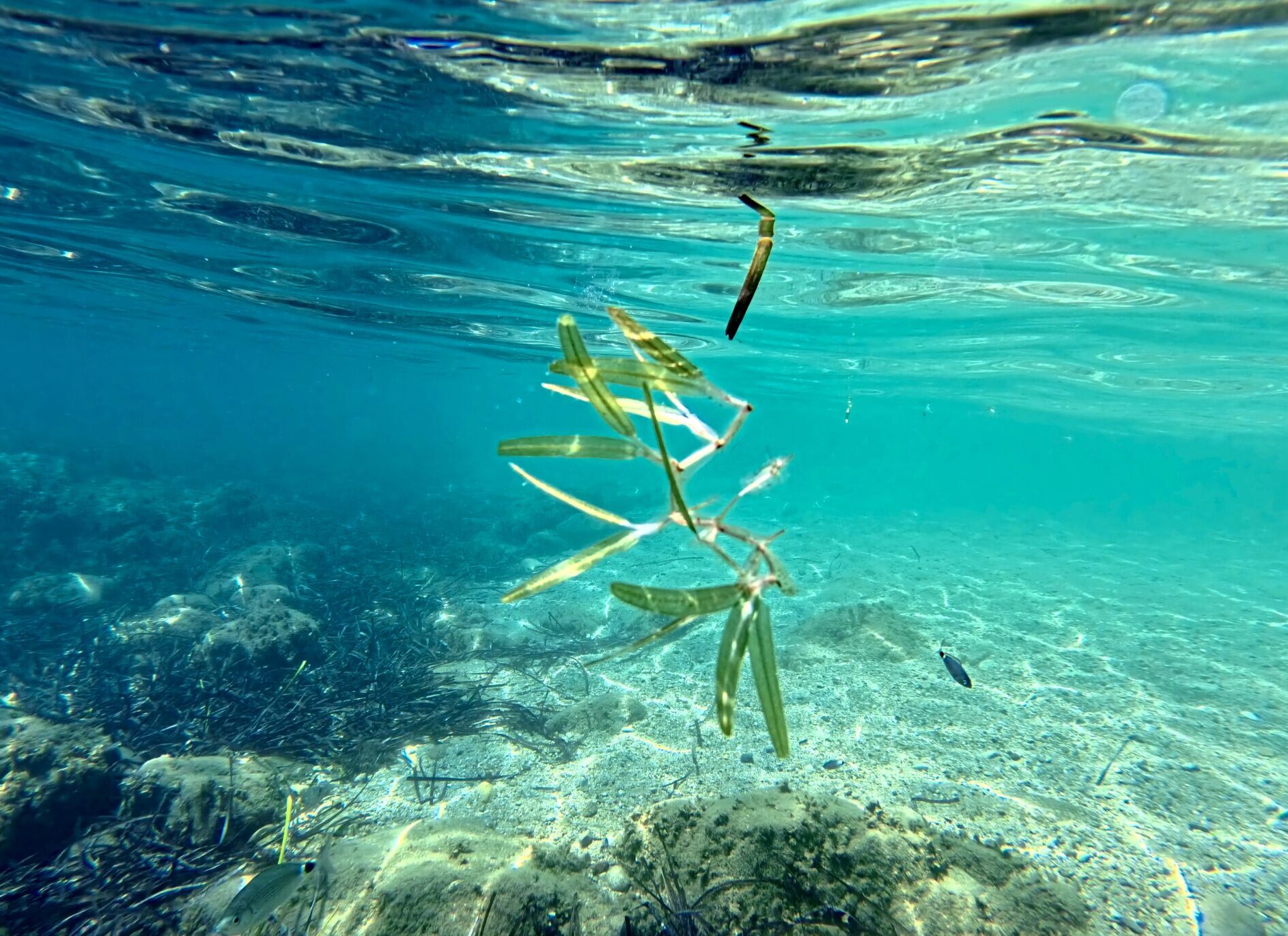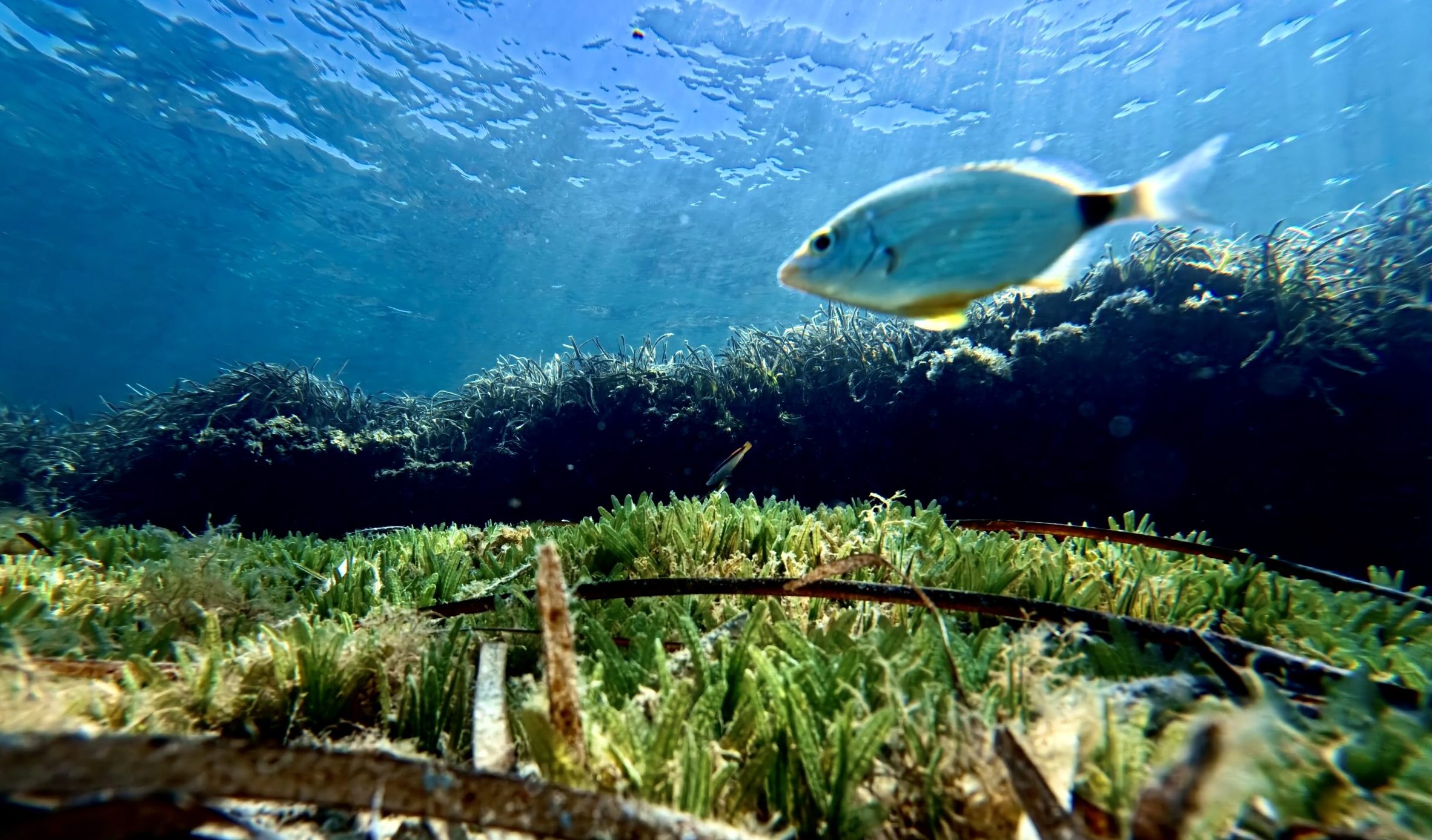
SUP and dolphins in Sardinia: when you enter their world
24 June 2025
SUP and dolphins in Sardinia: when you enter their world
24 June 2025Imagine the Mediterranean seabed as a living canvas, painted for centuries with the familiar patterns of Posidonia oceanica — a marine plant that safeguards the balance of our sea and shelters extraordinary biodiversity.
But today, an unexpected guest is rewriting this underwater landscape in different shades: Halophila stipulacea.
Although it was first recorded in 1894, only in recent decades has its expansion become rapid, steady, and overwhelming — fueled by warming waters and maritime traffic through the Suez Canal.
This alien plant is colonizing vast stretches of seabed, modifying the composition and structure of benthic ecosystems, including critical habitats like Posidonia meadows.
Why are we talking about it? Because it’s the visible symbol of a profound transformation occurring in the Mediterranean. Climate change is no longer a distant scenario — it’s real, present, and pulsing beneath the surface of our sea.

Halophila stipulacea: profile of an alien species
Small, flexible, persistent. And for that very reason — hard to stop.
Native to the Red Sea, Halophila stipulacea is a non-native marine angiosperm and today one of the most widespread invasive species in the Mediterranean (Tsiamis et al., 2020 – ISPRA).
Its thin, opposite leaves grow on branched rhizomes that anchor to the seabed, quickly forming dense mats that can smother entire seagrass meadows.
Its remarkable ecological plasticity allows it to thrive from shallow coastal zones to depths beyond 50 meters, tolerating wide ranges of salinity and temperature (IUCN, 2020).
And that’s not all: it reproduces both vegetatively, via rhizomes, and sexually, producing seeds that can disperse over long distances. This dual reproductive strategy is the key to its invasive success (Khan et al., 2021).
But how did it get here?
Its introduction into the Mediterranean is linked to the Suez Canal — an artificial corridor that has allowed hundreds of tropical species to migrate into our sea. This phenomenon is known as Lessepsian migration, named after Ferdinand de Lesseps, the engineer who designed the canal.
After a slow start, its spread was accelerated by climate change, which has made the Mediterranean an increasingly suitable habitat (UNEP/MAP RAC-SPA, 2022).
In many areas, Halophila is replacing native species like Cymodocea nodosa, and in the most critical cases, Posidonia oceanica — which takes much longer to regenerate.
🧠 Did you know?
A single Halophila stipulacea plant can cover more than one square meter in just a few months.
By comparison, Posidonia oceanica may take years to restore an area of similar size.
That’s one of the reasons Halophila is so difficult to control: it grows faster than the sea can defend itself.

An unstoppable invasion fueled by climate change
So, what is the true impact of this colonization?
Halophila stipulacea is advancing with a force few could have foreseen. Its colonies now spread across areas once dominated by lush Posidonia oceanica meadows → [Posidonia oceanica: the hidden breath of the Mediterranean Sea], disrupting the delicate balance of marine life long intertwined with these habitats.
The meadows it forms are simpler and less welcoming.
The result? A decline in biodiversity: fish, invertebrates, and other marine organisms lose habitats, food sources, and stability. This triggers a ripple effect throughout the entire food web.
Recent studies show that this transformation is accelerating, especially in parts of the Mediterranean experiencing higher warming trends, threatening the resilience of coastal ecosystems (Winters et al., 2020; IUCN Mediterranean Marine Red List, 2021).
In Sardinia, along the northeastern coast — particularly around Golfo Aranci — Halophila stipulacea has become a constant presence. It weaves between the blades of Posidonia oceanica, disrupting the ancient balance that has shaped these seabeds for centuries (Marini et al., 2019; Carta et al., 2021).
At Sardinia on Board, we see it every day, with our own eyes.
During our SUP tours, we take people to places we've known for years — and yet, each season we find them changed.
Posidonia retreats. Halophila advances.
We witness this transformation tour after tour, seabed after seabed. It’s not just a biological fact: it’s a tangible, urgent signal.
That’s why we’ve chosen to tell its story, with passion and respect — and to involve those who paddle with us in a journey of active observation and awareness. Because knowing is the first step toward protecting.

The Mediterranean is changing.
Halophila stipulacea is not just an alien species: it’s a wake-up call. It proves that our marine ecosystem is fragile, exposed, and in need of our care.
At Sardinia on Board, we believe that to truly experience the sea is also to protect it, with awareness and respect.
Here’s how you can help:
- Report changes in seagrass meadows and sightings of invasive species
- Promote tourism that respects marine ecosystems
- Avoid anchoring in sensitive seagrass habitats
- Spread awareness and love for native seagrasses
🌊 Experience the Mediterranean with us: join our SUP tours and discover — and protect — the underwater world we all share.
[Book now]
The sea is not just water.
It’s life, history, identity.
Protecting it means protecting ourselves.
Together, we can make a difference.

